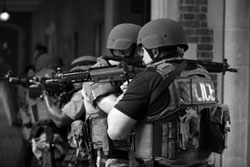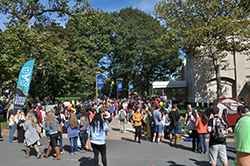The University put on an Active Shooter Presentation on Friday, September 13 to teach students and staff how to react in this situation and ways to prevent it.
An active shooter can strike in three different kinds of locations; the “kill-zone,” “non-kill-zone” and in an “open area.” Of these three locations, Bill McElrath, Chief of University Police, who gave the presentation, made it clear that the first reaction must always be to have a “survival mindset.”
Having a “survival mindset,” is to reassure yourself that you are going to get out of the situation alive and that you will not sit back and be defeated, explained McElrath. “You have to get in your head that at this point on, you are going to go home that night,” he said.
A common mistake made when faced with an active shooter is to deny that the situation is occurring. Thoughts such as, “No, this could never really happen to me,” will only waste time that you could be using to save yourself. “If an incident happens, you are going to take action; whether it is to run, to hide or whether it is to fight,” McElrath said.
While the shooter can strike at any of the three types of locations, each reaction should have similar results. The “kill zone” is the same room as the shooter. A “non-kill zone” is a room close-by the shooter where the shots can be heard, and the “open area” is any area with a large amount of space. McElrath explains that in each location a plan must be quickly created and action must be taken.
McElrath also mentioned a few safety tips. If victims are in a room with other people, students must spread out so that the shooter can’t attack them all at once. A way to distract the shooter from taking action is to throw items at him as quickly as possible. If the course of action is to hide, students must turn off all lights, cellphones and other sounds in the room while barricading the doors.
Once the victim is safe, either outside of the building, in a closet or behind a tree, a police officer should be immediately contacted with as much information as possible. This includes the appearance of the shooter, the location it took place, the amount of people affected and any injuries.
McElrath also explained that when in a shooter situation, victims must realize that the police must catch the shooter before they can help others. Therefore, if a police officer enters the room, victims must lift their hands to demonstrate they are innocent and wait until the shooter is caught.
“These aren’t people that just wake up in the morning and say, ‘I’m going to shoot up a school,’ these things are thought out,” said McElrath. The act is a well thought out plan but it can be prevented.
Recent studies show that 50 percent of shooting attackers have planned the incident for over two weeks, McElrath said. Also, in 81 percent of these acts, at least one person had previous knowledge of the threat.
Tom McCarthy, Assistant Director of Counseling and Psychological services, who also spoke during the presentation, shared ways to notice a shooter before the incident takes place. “They are acting very differently, they are dressing differently, they are really disheveled, they’re angry, they’re withdrawn and not talking to you,” said McCarthy. “Those are some of the behaviors that we would like you to pass on to us.”
McElrath shared the five stages a shooter will experience before the incident occurs. The first stage is the fantasy stage, where the shooter first takes the act into consideration, begins drawing pictures or writing stories about shooting others.
The second stage is the planning stage, where the actual incident is thought out and a list of needed items is written.
The third stage is the preparation stage, where the shooter retrieves each needed item to execute the plan. At this stage, the shooter familiarizes themselves with the area, practices shooting and is prepared.
During the fourth stage, known as the approach stage, the shooter begins to take action. Finally, during the fifth and final stage the implementation of the shooting takes place. The shooter will begin shooting until everyone around him is killed or there is no ammunition left. “Often times they will commit suicide or he’s killed or attacked by the police,” said McElrath.
McElrath reminded students that any shooter incident can be prevented if it is reported to the police. “Give us a call, that is what we are here for,” he said
University students who attended the presentation felt they learned valuable information. “If that would happen, I feel more prepared instead of just, ‘oh man, what do I do,’” said Jessica Nannemann, freshman animations major.
Mariah Jacobson, sophomore criminal justice major agreed, “The examples that they gave were very specific and I think every student should see it. I think it would help in case a situation like that would happen.”
The Active Shooter Presentation was originally created by McElrath after the Virgina Tech shooting occurred in 2007. He explained that after the recent Sandy Hook Elementary School shooting, there was more of an interest for the presentation.
McElrath explains that the University has a highly visible law enforcement presence and response capability along with multiple means for reporting emergency situations.
McCarthy advises students to report any suspicious behavior. “No matter how small it is, if something doesn’t feel right, if something doesn’t fit right with you, tell somebody about it,” McCarthy said.
“Somewhere, at some University, an individual is fantasizing, drawing pictures, making a list, are you ready?” asked McElrath.
PHOTO TAKEN from news.richmond.edu




